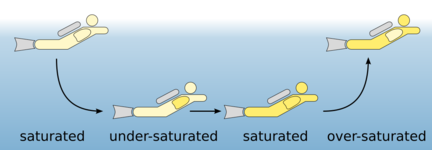Decompression sickness
A decompression sickness – also called diving or Caison disease, abbreviated DCS or DCI for decompression illness – refers to a disease pattern caused by gas bubbles in the body tissues.
Gas bubbles build up when inert gas – nitrogen in most of the cases – was saturated in the body tissue due to elevated ambient pressure over a defined time and the pressure then was suddenly reduced, that the gas cannot be kept in solution and therefore bubbles out.
Contents
Basic knowledge for Open Water Diver* (OWD*)
Causes
When diving you breath air under increased pressure and respectively increased density. The contained nitrogen is an inert gas. It does not participate in metabolic processes in the body, but it dissolves in the body tissues, that contain a large amount of water, and is saturated there.
Saturation always takes place when there is more nitrogen in the breathing gas than is dissolved in the body. Conversely, when the ambient pressure is reduced, desaturation of the tissues takes place as the partial pressure of nitrogen in the breathing air decreases. How fast our body tissue saturates or desatures varies depending on the type of tissue and how good blood circulates through it (see article section Half-value time in article Inert gas saturation).
If too much nitrogen is saturated in the body and the ambient pressure drops to rapidly during a too fast ascent, the nitrogen can no longer stay in solution and gas bubbles build up into the body tissues.
Symptoms
The gas bubbles cause different symptoms, depending on where they are located and how pronounced they are:
- Very small bubbles, called microbubbles, often cause abnormally severe tiredness and fatigue.
- Under the skin, there can appear spots similar to bruising and itching.
- In the musculature they cause pain and pressure sensitivity, which resembles a muscle soreness.
- In joints, bones and ligaments they cause pain which may lead to a restriction of movement (so-called bends).
- In the blood vessels, they can block the blood supply to individual areas in the body, blocking the supply of oxygen and nutrients. This causes death of cells in the affected area.
- Gas bubbles in the brain and spinal cord or blockage of blood vessels cause impaired consciousness and paralysis. The symptoms are similar to a stroke. Such damage can be irreversible and may even lead to death.
The symptoms do not necessarily occur immediately after the dive, but can occur up to 24 hours later.
Primary treatment
If symptoms of a decompression sickness occur, this must be treated as a medical emergency and the rescue services must called immediately.
In any case, even after dives with enriched air nitrox, 100% oxygen has to bed admitted immediately and if possible until emergency services arrive. Due to the higher oxygen content in the blood, it might be possible to still get enough oxygen to partly blocked areas and prevent important body cells from dying. Subsequently, a stay in a pressure chamber is usually necessary in order to reduce the size of the gas bubbles and bring them back into solution and then desaturate the tissue by slowly reducing the ambient pressure.
Preventive measures
To reduce the risk of decompression sickness, it is important to dive responsibly within the limits given by your diving computer or calculated using your dive table. This means that the ascent rate must never exceed 10 meters per minute, a safety stop should be carried out and all necessary decompression stops must be observed. How to finish your dive savely, perform decompression stops and further safety information can be found in the article decompression calculation.
Weiterführende Literatur
- Secchi, Ziegenfuß: Tauchunfälle; In: Checkliste Notfallmedizin; Thieme, Stuttgart, 2009
- Bühlmann, Völlm, Nussberger: Inertgasaufnahme- und abgabe des menschlichen Körpers; In: Tauchmedizin: Barotrauma Gasembolie Dekompression Dekompressionskrankheit Dekompressionscomputer; Springer, Heidelberg, 2002
- Schmidt, Lang, Heckmann: Herz und Kreislauf; In: Physiologie des Menschen; Springer, Heidelberg, 2010
- Bernau: Gewebemodelle; In: Trimix - Tauchen jenseits der Sporttauchgrenzen: Der freie Fall ins Nichts – Tauchen in der Königsklasse; Neobooks, Berlin, 2014
